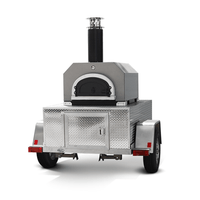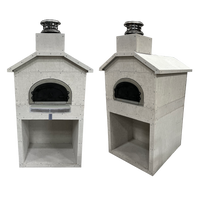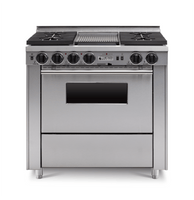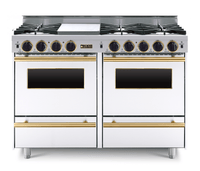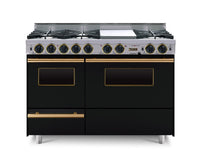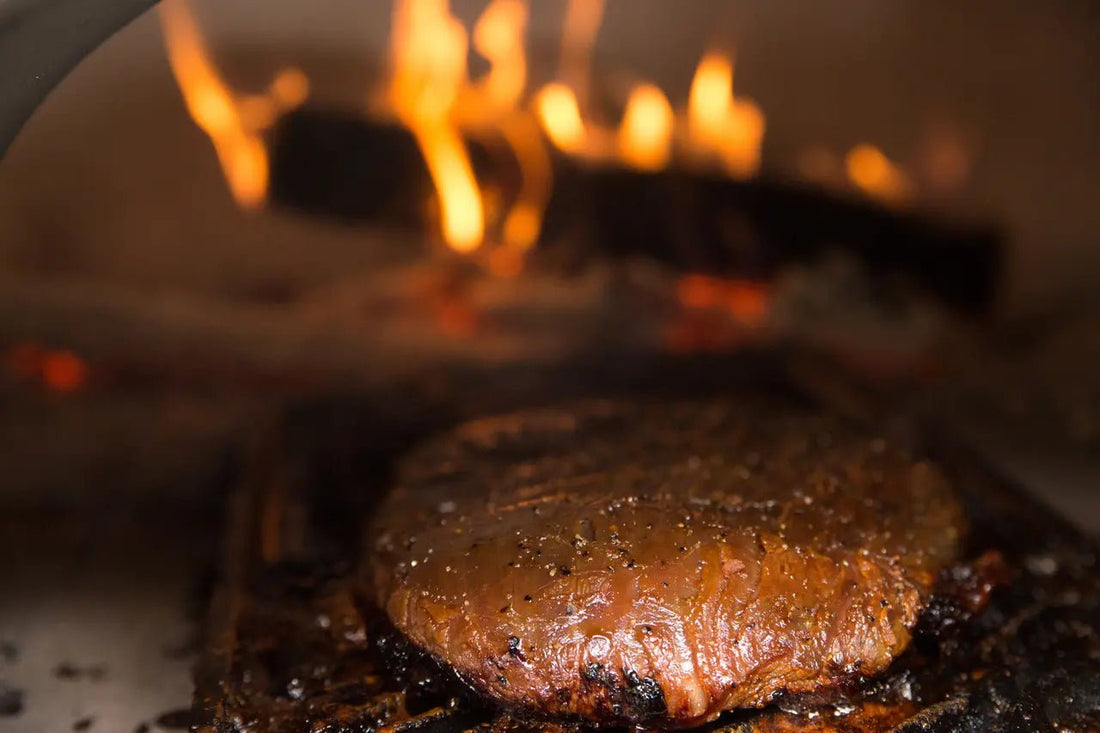Mastering Brick Oven Steaks: A Culinary Guide
Welcome to the ultimate guide on perfecting steak with the high heat of a brick oven. If you’ve only thought of your oven as a haven for pizzas, prepare to be amazed. Our tutorial is poised to show you how the intense heat of a Chicago Brick Oven is not just for pizza but is a prime setting for a sumptuously seared steak or a steak in a pizza oven. Keep reading as we uncover how to pick the best cut, prepare it for the sizzle, and manage the roaring heat to deliver a steak that could take pride of place in any top-tier steakhouse. Get ready to transform your backyard cooking with skills that meld tradition with innovation, guaranteeing applause at your next al fresco gathering.
Selecting the Right Steak for Your Brick Oven
In my journey of perfecting my grilling craft, I’ve realized that the right cut of steak is not just about preference; it’s a cornerstone of brick oven cooking excellence. Thickness plays a pivotal role as it directly influences how the meat absorbs heat and develops a crust. With my Chicago Brick Oven roaring to life, I found that thicker cuts stand up better to the intense, direct heat. But it’s not only about thickness; certain cuts, like ribeye or porterhouse, inherently possess the qualities that thrive in the high-heat environment of a brick oven. Marbling – the small streaks of fat throughout the meat – is another critical factor, as it melts and bastes the steak from within, imparting that irresistible flavor that only a well-marbled steak can offer. And let’s not overlook the crucial step of proper seasoning; a generous sprinkle of salt can transform a good steak into an unforgettable culinary experience.
The Importance of Steak Thickness
In my experience with brick oven cooking, the rule of thumb has always been that a thicker cut of beef ensures a more even cook and a steak that’s robust enough to handle the high heat without drying out. With a recipe that calls for a heavy char, the dense structure of a substantial cut maintains inner succulence, giving you the contrast between a crispy exterior and a tender, juicy center that’s a signature at any barbecue. watch our tutorial
While crafting the perfect steak, I’ve learned that consistency in thickness is paramount. It allows for precise timing – a crucial element in achieving that ideal medium-rare or well-done finish. A uniform cut also prevents thinner parts from overcooking while waiting for thicker sections to reach the desired temperature. On a personal note, seasoning with black pepper right after the salt application accentuates flavors just as well with chicken, enhancing the versatility of my recipe arsenal.
Best Cuts of Steak for High Heat
In my pursuit to harness the intense atmosphere of my brick oven, I’ve zeroed in on cuts like the New York strip and the T-bone for their ability to withstand high temperatures. These prime selections, the heroes in my kitchen, achieve a sublime char without sacrificing their innate juiciness. With a light brush of oil before they hit the heat, and perhaps a touch of garlic, these steaks emerge as showstoppers, turning each meal into an event worth remembering.
Though often overlooked in favor of its more famous counterparts, the skirt steak offers remarkable sizzle and flavor when given the brick oven treatment. I relish watching it sear quickly over the embers, the smoky aroma melding with the rustic scent of garlic and oil. Pair it with a robust sauce, and I guarantee your guests will be inquiring not just about the recipe, but also where they might find such quality cuts at a favorable sale price.
Marbling Matters for Flavor
The intricacies of marbling in a steak play a significant role in the final taste and texture of the dish when using a Chicago Brick Oven. Threading through the beef, this interlacing of fat melts into the meat during its close encounter with heat, acting much like butter in a cast iron pan. As this internal basting takes place, the steak naturally absorbs these flavorful juices, enhancing its succulence and making each bite a fresh indulgence.
Utilizing the high temperature capacity of my Chicago Brick Oven, I can maximize the marbling benefits, which are crucial for locking in flavors. Marbled steak, with a light brush of olive oil before searing on the heated iron surface, undergoes a transformation, emerging with a delectable crust. This marriage of high-quality marbling and the correct cooking technique ensures a steak that rivals those served in the finest establishments.
Prepping Your Steak for the Brick Oven
Embracing the art of steak preparation is a necessary prelude to utilizing a Chicago Brick Oven, where the raw power of fire transforms basic components into a symphony of flavors. Just as a skilled baker understands the delicate balance of clay, bread, and the perfect crust, so too must a grill master fathom the interplay of simple yet intentional seasoning, the choice of marinating, and the crucial step of tempering the meat to room temperature. Mastering these elements is not just about enhancing taste; it’s about ensuring that the natural essence of the meat, complemented by the rendered fat and caramelized sugars, performs exquisitely in the fervent dance of high-heat cooking.
Seasoning Your Steak Simply
My go-to approach for seasoning steaks destined for the brick oven revolves around simplicity, a method that allows the prime flavors of the rib cut to take center stage. A light drizzle of olive oil, just enough to coat the surface, prepares the steak to evenly receive the salt, ensuring an exquisite crust that complements every item on my menu, from salads to vegetable sides.
Against the intense backdrop of a blazing brick oven, complexity in seasoning can detract from the natural splendor of a well-chosen steak. Hence, my culinary doctrine is to use minimal garnishes, relying on quality ingredients like fresh-cracked pepper to harmonize with the olive-enhanced rib, crafting a sublime taste that elevates the humblest salad or vegetable accompaniment into a complete and refined gastronomic experience.
To Marinate or Not to Marinate
Deciding whether to marinate steaks before introducing them to the fervent embrace of a brick oven involves weighing the desire for enhanced flavor against the purity of the meat’s taste. Personally, I tend to steer away from heavy marinades which can mask the subtle nuance of smoke that a quality charcoal oven imparts. However, a simple marinade incorporating elements like onion or herbs can sometimes accentuate the steak’s natural profile without overwhelming the senses.
Moreover, when considering marination, I reflect on the level of doneness I aim to achieve. A brief, acidic marinade can begin the tenderization process, desirable for certain cuts that benefit from it during the journey to perfect doneness. Yet, with high-quality cuts that I prefer to showcase, simple seasonings remain my go-to tool—ensuring the steak’s intrinsic flavors, along with a perfect char, remain the stars of the show.
Bringing Your Steak to Room Temperature
Before a steak graces the heated stone of my oven, I ensure it rests at room temperature, which could be as crucial as finding the right price on a premium cut. This step is as pivotal to a successful meal as the perfect pairing of wine with seafood; it guarantees an even cook, allowing the steak to bask in the oven’s ambient heat, ultimately rendering the marbling just right.
Treating a steak to this tempering period is akin to garnishing a dish with a dash of parmesan—it’s a simple action, but the enhancement to flavor and texture is undeniable. As the steak gradually acclimates, the fibers relax, akin to how a good bottle of wine breathes, ensuring every slice is a tender delight, ready to be savored and celebrated at any meal.
Mastering Your Brick Oven’s Temperature
Navigating the heat dynamics of a Chicago Brick Oven can be as nuanced as selecting the right blend of salt and pepper to enhance the flavors of a prime cut of steak. Picture stepping into the warmth of a kitchen where the rich smell of sea salt enhances the air—this is the essence evoked by my brick oven when it reaches optimum temperature. Learn how to fire up your Chicago Brick Oven here. Recognizing this perfect heat is not unlike the excitement of receiving a gift card to a gourmet store; it heralds the potential for culinary greatness. In this part of the guide, I’ll impart wisdom on how to gauge the oven’s temperature accurately, understand the significance of hot spots for steak placement, and offer insights on fine-tuning cooking times. And just as delicately balancing a hint of banana in a dish can intrigue the palate, managing heat with precision can intrigue the senses and transform a simple steak into an extraordinary meal.
Adjusting Cooking Times Based on Temperature
The relationship between temperature and cooking time is as delicate as the zest of lemon gently folded into a dish. When I cook pork or brisket in my Chicago Brick Oven, for instance, I meticulously adjust the duration based on the thickness of the cut and the oven’s temperature, much like I would modify the quantity of herb seasoning to suit a tablespoon of sauce – it requires precision and a nuanced understanding.
In my practice, adapting the cooking time to the oven’s heat has resounding effects on the outcome of the meal. A simple deviation can turn a steak from succulent to overdone. Therefore, as I manage the ember-fed warmth, I remain vigilant, adjusting the steaks’ exposure to echo the same care I would employ in moderating a tablespoon of lemon or herb throughout cooking – ensuring every slice of meat is as tender and flavorful as intended.
Cooking Techniques for Brick Oven Steaks
Transitioning from the preparatory steps of picking and prepping steak to the dance of fire and heat, I approach my Chicago Brick Oven equipped with techniques poised to conquer any cut. A searing crust, emblematic of culinary excellence, starts with the high heat of my oven’s bricks, much like the sear from a sizzling frying pan. Alternately, the choice between a cast-iron skillet and the direct flame carves out distinct flavors and textures, reminding me of the cooking traditions rooted in the hearths of France. Adapting the Italian aromas of rosemary, my culinary experiments often involve a Tuscan grill, lending a rustic smokiness that complements the coarse texture of Himalayan salt. Through thoughtful observation and a careful touch—insights honed far from the inside of a refrigerator—I’ve trained myself to test for doneness, gaining the ability to discern the right moment of perfection, guided by look and feel rather than relying solely on a thermometer.
Searing for the Perfect Crust
My approach to searing in the Chicago Brick Oven mimics the intensity of a roaring wood fire, crucial for that sought-after crust. Positioning the steak directly on the brick, where embers glow and the wood has imparted its smoky essence, creates an unparalleled char. Transferring the finished steak onto a cutting board, I let it rest, knowing the crust’s perfection is a silent nod to the oven’s robust capabilities.
The subtle hint of a clove or the sweet aroma of a peach can elevate a dish, just as the searing heat from a brick oven elevates the steak’s crust. Should you ask me for this searing technique via email address, I’d emphasize the importance of this high-heat method in developing flavors that only a brick oven can coax out, a tribute to the harmony of fire, meat, and culinary prowess.
Using a Cast-Iron Skillet vs. Direct Heat
Introducing a cast-iron skillet into the realm of brick oven cooking opens up new dimensions of flavor. The dense material of the pan is perfect for creating a heat reservoir that gives the steak a uniform crust, akin to the golden bubbling surface on a well-baked cheese. This technique also provides an avenue for incorporating additional elements, such as a teaspoon of your favorite herbs, to imbue the steak with deeper flavors.
While a pan offers its advantages, there’s a distinct benefit to cooking directly on the brick oven’s heated surface. The direct contact with the fiercer heat develops a crust that’s in a league of its own, capturing the essence of flame-kissed steak that you simply cannot replicate in a skillet. And after mastering this method, you’ll find every steak that comes out of your brick oven justifies the ‘add to cart’ action for a Chicago Brick Oven, turning your backyard into an emblem of high-temperature culinary excellence.
Using a Tuscan Grill
Integrating a Tuscan grill into my brick oven steak preparation has accentuated the grilling process, bolstering its functionality for outdoor cooking enthusiasts. This accessory, positioned over the scorching cooking brick and hot coals, delivers an even distribution of heat that a mere glance at my meat thermometer confirms is perfect, often reducing the grilling minutes without sacrificing the rich, smoky flavor imparted by the open flame.
Employing this method, the Tuscan grill’s elevated platform morphs into a stage where the steak, drizzled lightly in olive oil, receives not only the high heat necessary for a quick sear but also the nuanced smokiness unique to wood-fired cooking. The grill marks serve as a testament to the effectiveness of this method, and with my trusty thermometer in hand, I ascertain the meat’s doneness to an exactitude that would satisfy any culinary aficionado.
Testing for Doneness Without a Thermometer
Mastering the art of gauging steak doneness by touch and sight is a skill akin to finely chopping parsley with precision—both depend on a keen sense of texture and detail. As my steak sizzles within the Chicago Brick Oven, I use the press test, applying gentle pressure to the meat; when it yields slightly but springs back, similar to the resistance of a fresh-cut, it whispers tales of a perfectly medium-rare to medium doneness.
In the absence of a thermometer, I judiciously watch for signs around the corners of the meat, where the juices begin to surface—a telltale hint much like a crisp edge on roasted vegetables. I also notice how the juices run clear when the steak is prodded with a fork, a visual gift that speaks volumes about the readiness of the meat, more so than any numerical reading gift cards could procure.
Resting and Serving Your Brick Oven Steak
After artfully commanding the flames and heat of a Chicago Brick Oven to achieve that impeccable sear, my attention shifts to the vital practices post-grilling—those final blocks to place before the grand reveal. Understanding the importance of resting your steak is as central to meat preparation as is selecting the right cuts of meat; this crucial pause allows juices to redistribute, ensuring each slice is succulent and robust with flavor. It’s also the moment for my metal tools to take a short hiatus and for the meat’s fibers to relax. Armed with my chef’s knife, I then meticulously slice against the grain, transforming robust cuts of meat into tender servings that easily yield to the fork. To round out the sensory delight, I mindfully curate sides that meld with the steak’s smoky profile—perhaps a selection of roasted fruit to contrast the savory notes—and select wines that echo the depth and body of the flavors on the plate. All of this comes together to culminate in a harmonious dining experience that speaks volumes of the artistry behind brick oven mastery.
The Importance of Resting Your Steak
A proper rest for your steak, much like the patience required when waiting for cream to settle to the perfect consistency, is not to be underestimated. This pause is the unsung hero of the culinary process, crucial for a juicy steak; it reabsorbs and redistributes the juices, preserving the tenderness and moisture that might otherwise escape onto the cutting board.
While some might overlook this stage in haste, the cookbook of my experiences has taught me that the magic of cardamom doesn’t rush its release of flavors, and similarly, a steak’s essence is heightened when given time to integrate its flavors post-cooking. Resting, therefore, allows the intricate notes, perhaps as subtle as rhubarb in a sweet tart, to fully develop and mature, creating a symphony of taste in each bite.
Cutting Against the Grain
As I draw my blade across the rested steak, I’m always mindful to cut perpendicular to the muscle fibers, which is known as cutting against the grain. This technique ensures the most tender eating experience, as it shortens the fibers and makes them easier to chew.
Slicing the steak this way is almost like unwrapping a gift; it reveals the care that went into cooking and honors the texture and juiciness that was so meticulously crafted in the heat of the brick oven.
Pairing Sides and Wines With Your Steak
As I contemplate pairing sides with my robust brick oven steaks, I gravitate towards simple yet elegant complements, like a warm potato salad tossed with fresh herbs and a hint of Dijon mustard, adding a touch of piquancy that meshes seamlessly with the smokiness of the steak. An array of grilled vegetables drizzled with balsamic reduction can also act as a vibrant counterpart, their charred edges echoing the steak’s seared crust.
Choosing the right wine to accompany my steak transforms the meal into a celebration of flavors. I opt for a full-bodied red like a Cabernet Sauvignon or a Malbec, both boasting a bold character that stands up to the richness of the meat without overshadowing its nuanced seasoning. The perfect wine selection enhances the dining experience, creating a harmonious balance on the palate just as the ideal oven temperature complements the meat’s texture.
Cleaning and Maintaining Your Brick Oven
In my pursuit of culinary perfection with my Chicago Brick Oven, attention to detail doesn’t end with the last bite of a succulent steak. The lifecycle of a memorable meal also includes the essential, yet often overlooked, post-cooking rituals of cleaning and maintaining this remarkable cooking tool. Beyond the immediate satisfaction of a well-cooked meal lies the responsibility of care and upkeep, which ensures that my oven stands ready for my next gastronomic endeavor. In sharing my regimen, I’ll cover not only the specific steps that keep my oven pristine after use but also the frequent maintenance tasks that contribute to its longevity. Moreover, my experiences have equipped me with insights to troubleshoot common brick oven conundrums, preserving the integrity and performance of my cherished culinary centerpiece.
Post-Cooking Cleaning Tips
Ensuring the longevity of my Chicago Brick Oven involves a meticulous cleaning process after each use. By discarding ash and food remnants while the oven is still warm yet safe to touch, I decrease the likelihood of burnt-on debris, maintaining a pristine cooking surface for future steak-mastering endeavors.
Following a high-heat cooking session, I swiftly brush the bricks with a dedicated oven brush, a gesture reminiscent of an artist tenderly caring for their brushes after painting. This habit not only keeps the cooking area hygienic but also preserves the integrity of my oven’s floor, ensuring it remains capable of producing evenly cooked, flavorful steaks for years to come.
Regular Maintenance for Longevity
Maintaining my Chicago Brick Oven isn’t just an afterthought; it’s a ritual that ensures each steak cooking session is as successful as the last. Regular inspection and minor repairs, such as checking for any cracks and resealing joints with refractory mortar, maintain the structural integrity vital for the consistently high performance of my culinary arsenal.
Moreover, I prioritize periodic deep cleans, often at the start or end of the grilling season, to attend to any accumulated residue.
Conclusion
Mastering the art of cooking steaks in a Chicago Brick Oven enables the creation of flavorful, succulent meats with an unparalleled crust. The process demands a thoughtful selection of cuts, meticulous preparation techniques, and an understanding of the oven’s temperature dynamics. By perfecting these elements, each steak becomes a showpiece, and the result is a dining experience that elevates outdoor cooking to new heights. Through routine maintenance and a commitment to the craft, this guide ensures that brick oven steaks are consistently celebrated as culinary achievements.

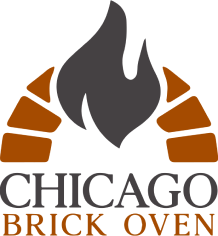
 Call Us
Call Us

